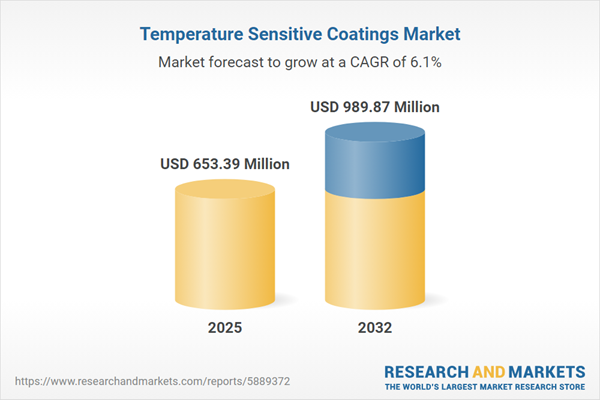Speak directly to the analyst to clarify any post sales queries you may have.
Temperature sensitive coatings are rapidly reshaping industrial product design and supply chain efficiency, providing leaders with transformative options to enhance durability and sustainability. As global industries innovate for operational excellence, this market’s growth is propelled by advances in material science, regulatory change, and dynamic application landscapes.
Market Snapshot: Temperature Sensitive Coatings Market Overview
The Temperature Sensitive Coatings Market grew from USD 616.43 million in 2024 to USD 653.39 million in 2025. It is expected to continue growing at a CAGR of 6.09%, reaching USD 989.87 million by 2032.
Adoption rates are expanding as temperature sensitive coatings enable adaptive performance, particularly valuable in sectors prioritizing real-time thermal regulation. Demand is pronounced in industries facing shifting standards for product efficiency, supply reliability, and sustainability. Supply chains and procurement strategies are evolving to reduce dependency on volatile international channels and adapt to regulatory headwinds.
Scope & Segmentation: Technology, Formulation, and Regional Focus
- End Use Industry: Aerospace, automotive, electronics, energy, healthcare
- Technology: Thermochromic (leuco dye, liquid crystal, thermotropic), thermoelectric, thermoresistive (NTC, PTC)
- Formulation: Powder based (epoxy powder, polyester powder), solvent based (acrylic, alkyd), water based (emulsion, latex)
- Temperature Range: High, medium, and low temperature coatings
- Geography: Americas (North America—United States, Canada, Mexico; Latin America—Brazil, Argentina, Chile, Colombia, Peru), Europe, Middle East & Africa (Europe—United Kingdom, Germany, France, Russia, Italy, Spain, Netherlands, Sweden, Poland, Switzerland; Middle East—United Arab Emirates, Saudi Arabia, Qatar, Turkey, Israel; Africa—South Africa, Nigeria, Egypt, Kenya), Asia-Pacific (China, India, Japan, Australia, South Korea, Indonesia, Thailand, Malaysia, Singapore, Taiwan)
- Major Companies: The Sherwin-Williams Company, PPG Industries, Inc., Akzo Nobel N.V., Nippon Paint Holdings Co., Ltd., RPM International Inc., Asian Paints Limited, Axalta Coating Systems Ltd., Kansai Paint Co., Ltd., Jotun A/S, Hempel A/S
Key Takeaways: Strategic Drivers for Decision Makers
- Temperature sensitive coatings are unlocking efficiencies in product life cycle management, enabling compliance with increasingly strict energy and environmental standards.
- Material innovations like nanocomposites and hybrid polymers are revolutionizing performance for mission-critical applications across major end-use industries.
- Integration with digital monitoring tools positions manufacturers to deliver data-driven insights, supporting predictive maintenance and long-term asset reliability.
- Adoption strategies vary by region, with North America and Asia-Pacific prioritizing high-performance and scalable production, while Europe, the Middle East, and Africa focus on environmentally responsible solutions.
- Collaborative development—between coating specialists, raw material suppliers, and end-users—is accelerating commercialization and helping align products with sector-specific operational requirements.
Tariff Impact: Influence of United States Trade Policy
Recent United States tariffs have prompted coating manufacturers to reconfigure sourcing by expanding domestic and regional partnerships. Those with diversified supply chains and agile pricing structures featuring cost-effective substitutes are better equipped to maintain market competitiveness under shifting trade rules. For lagging organizations, narrow supplier bases have resulted in thinner margins and delayed delivery timelines, underscoring the value of robust supply chain resilience and ongoing regulatory monitoring.
Methodology & Data Sources
This report uses a comprehensive research methodology integrating expert interviews, industry database analysis, and thorough reviews of technical publications, regulatory documents, and patent records. Stakeholder feedback and third-party validation panels ensure findings reflect the latest trends and consensus views across the coatings market.
Why This Report Matters
- Enables C-level executives to benchmark innovation, track regulatory developments, and seize emerging opportunities for portfolio expansion.
- Equips procurement and supply chain leaders with insights to optimize sourcing, manufacturing placement, and cost control in light of global policy shifts.
- Supports technology strategists and R&D directors in targeting the most commercially and technically relevant material advancements for new product launches.
Conclusion
Temperature sensitive coatings offer a pathway for industries to achieve next-level operational flexibility and regulatory alignment. Leaders acting on the actionable insights from this report will be best positioned to drive successful adoption and long-term, scalable growth.
Additional Product Information:
- Purchase of this report includes 1 year online access with quarterly updates.
- This report can be updated on request. Please contact our Customer Experience team using the Ask a Question widget on our website.
Table of Contents
3. Executive Summary
4. Market Overview
7. Cumulative Impact of Artificial Intelligence 2025
Companies Mentioned
The companies profiled in this Temperature Sensitive Coatings market report include:- The Sherwin-Williams Company
- PPG Industries, Inc.
- Akzo Nobel N.V.
- Nippon Paint Holdings Co., Ltd.
- RPM International Inc.
- Asian Paints Limited
- Axalta Coating Systems Ltd.
- Kansai Paint Co., Ltd.
- Jotun A/S
- Hempel A/S
Table Information
| Report Attribute | Details |
|---|---|
| No. of Pages | 199 |
| Published | October 2025 |
| Forecast Period | 2025 - 2032 |
| Estimated Market Value ( USD | $ 653.39 Million |
| Forecasted Market Value ( USD | $ 989.87 Million |
| Compound Annual Growth Rate | 6.0% |
| Regions Covered | Global |
| No. of Companies Mentioned | 11 |









